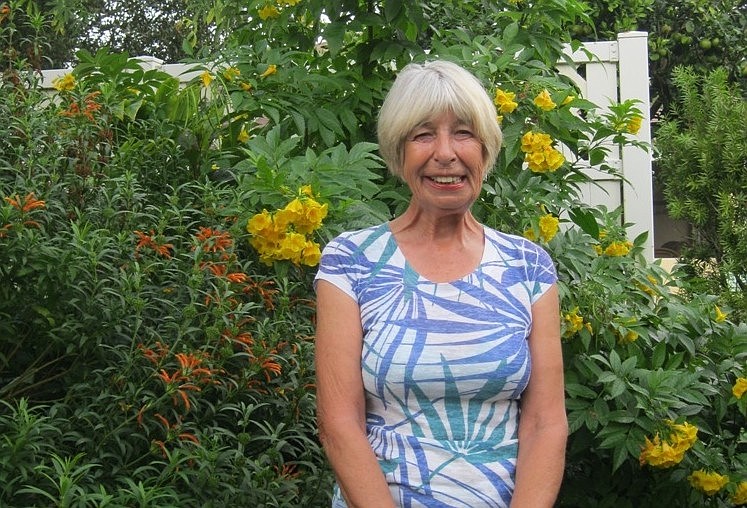- November 23, 2024
-
-
Loading

Loading

Jill Carpenter has gardening in her blood.
Even though she has a degree in hotel management, a field in which she worked for 22 years, she has been gardening since she was a young girl in London. Both her parents loved tending to plants — her father won many awards at local flower shows for his dahlias and sweet peas, and her mother won for her floral arrangements.
Jill and her husband, Jerry, moved to Palm Coast from St. Augustine in 2005 after living in London for 12 years, where Jill worked in landscape design.
They live in Quail Hollow, on a spring-fed lake. Most of the near-acre property is landscaped with more than 150 different plant species. With such a wide variety of vegetation, Jill says her favorite plants are native firebush, fragrant sweet almond, her Louis Phillippe antique roses and the unusual Buddha belly plant, with its swollen trunk. She enjoys these plants because they attract butterflies, bees and hummingbirds.
“There is a magical procession of birds in my yard,” she said, as we watched several doves leave the ground for a perch in one of the many oaks outside the lanai.
Jill's garden is a mixture of native and non-natives, which attract wildlife. In addition to birds and insects, there are deer that come to dine on the hibiscus and a resident armadillo she has named Fred that lives under her esperanza (yellow bells) bush, which now is in full bloom.
Having color in her garden year-round is important to her, and, this time of year, the yard is ablaze with yellow from the cassia bush, pink from the Camelia sasanquas, which bloom until December, magenta from the orchid tree and purple from the berries of the native beautyberry.
Like a true plant lover, Jill can't throw any plants away that she has divided or which have re-seeded. She shares them with friends and brings many in pots to The Garden Club at Palm Coast meetings to sell. For the past six years, she has propagated thousands of plants for the club’s annual spring plant sale, overwintering many in her propagation greenhouse.
Jill is also passionate about animals and is a board member and the fundraising coordinator for Journey's End Animal Sanctuary. You can visit her Tuesday mornings at the nonprofit's booth at the Salt Air Farmer's Market opposite Marineland.
BOX: What to do in the landscape this month
Now that the cooler weather has arrived, there are many projects you can perform to prepare your garden for colder temperatures. First, restrict your irrigation times to one day a week until early March, with odd-numbered residential addresses watering on Saturday and even-numbered ones on Sunday.
Remember, most plants should not be pruned until late February or early March when the chance of frost has diminished. Pruning too soon promotes tender new growth that is susceptible to freeze damage.
Replace dead or declining landscape plants. Divide and replant overgrown perennials and bulbs. If you have poinsettias, continue to feed them lightly once a month.
Fall is a good time to plant trees or shrubs. It's also a good time to plant cool-season annuals and perennials to add color to your garden. Some to try are alyssum, calendula, chrysanthemum, delphinium, dianthus, dusty miller, gaillardia, salvia and verbena. For the vegetable garden, continue to plant broccoli, cabbage, spinach, endive and onions. Herbs include chives, dill, fennel, lavender, parsley, rosemary, sage and thyme.